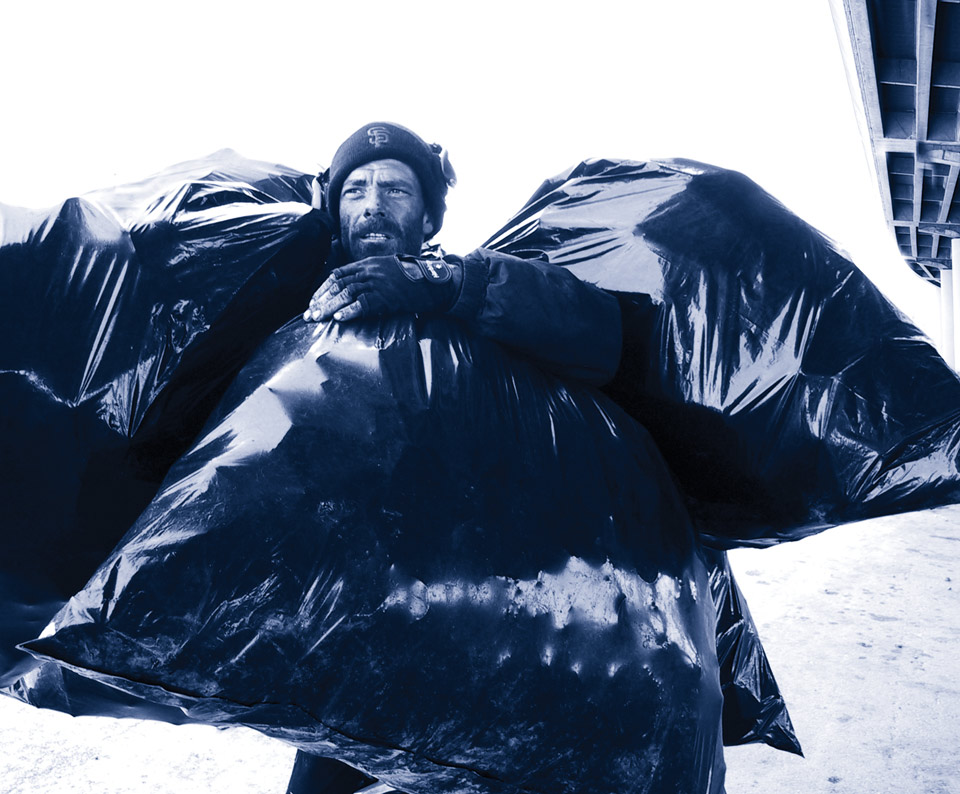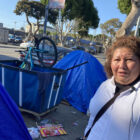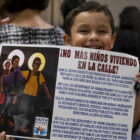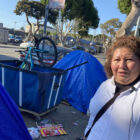In her new book on homelessness in San Francisco, “Hobos, Hustlers and Backsliders,” Teresa Gowan describes how former Mayor Frank Jordan’s framing of the issue in terms of crime and sin evolved into Willie Brown’s conflicted policies, finally emerging as Gavin Newsom’s version of “authoritarian medicalization” policies, most controversially the policy idea that got him elected in 2003, Care Not Cash. This essay condenses some of the discussion of the book (University of Minnesota Press, 2010).
San Francisco, a historical stronghold of the labor movement, civil rights activism and other social movement activity, embodies the tension between valuable public space and progressive politics to a high degree, an important reason for the central position of the “homelessness problem” in the city’s electoral politics over the last 25 years.
San Francisco, a historical stronghold of the labor movement, civil rights activism and other social movement activity, embodies the tension between valuable public space and progressive politics to a high degree, an important reason for the central position of the “homelessness problem” in the city’s electoral politics over the last 25 years.
The same streets which attract visitors from all over the world are also wandered by thousands of homeless paupers. In the 1990s the city’s rental market become one of the most expensive in the world, and threshold of homelessness dropped lower and lower. People with limited resources who insisted on staying in the city lost tenure in cheap apartments or hotels, and resorted to living in cars, homeless shelters and encampments under freeway bridges.
For many poor San Franciscans, the extraordinary strain of trying to maintain housing was compounded by an absence of strong social ties. As a great destination for cultural, economic and political migrants, more than half of the city’s population were born elsewhere and had no local family members to help them.
San Francisco represents a particularly important case of the criminalization of homelessness. Even in liberal San Francisco, the social construction of homelessness as bad behavior became powerful enough to propel large-scale police campaigns against nuisance offenses, repeated attempts to abolish general assistance, and numerous other programs aimed at pushing the “visible poor” back into invisibility.
The narratives activists and advocates had developed linking homelessness to system flaws (‘system talk’) gradually lost ground. Their emphasis on combating unemployment and low wages was drowned out by the kind of aggressive ‘sin-talk’ exemplified by San Francisco’s Police Chief-turned-Mayor Frank Jordan, which painted men and women living on the streets as dirty, dangerous blights on the social landscape. (Jordan’s Matrix program instituted a number of violations subject to citation or arrest, all of them aimed at curbing the behavior and presence of homeless people downtown. Some of the offenses included blocking the sidewalk, aggressive panhandling and urinating outdoors.)
Equally important, though, was the rise of ‘sick-talk’:narratives defining homelessness as a symptom of individual pathologies, especially substance abuse and mental illness. Nurtured within the professionalizing agencies and shelters, medicalized discourses on homelessness were developing a formidable institutional base, unlike the systemic critique of the cash-strapped activists.
Mayor Willie Brown’s administration energetically pursued clearance, but the mayor still seemed conflicted about his position on the city’s persistent “homeless problem.”
Brown’s public statements on homelessness remained split between primarily aesthetic justifications of the police sweeps and his continued effort to present himself as a defender of the poor.
At this point, many other Democratic public officials had abandoned system-talk about poverty and homelessness. President Bill Clinton was skillfully navigating the shoals of welfare reform and Democratic politicians across the country were developing parallel strategies for withdrawing citizenship rights and existing social entitlements in the name of “tough love.” It was only a matter of time before San Francisco’s leaders created their own Clintonesque combination of therapeutic and punitive discourses on homelessness.
Spearheading the breakthrough in the early 2000s was ambitious young Gavin Newsom, then a member of the Board of Supervisors. Seeing that visible homelessness continued to create consternation among business interests and the electorate, Newsom tied his bid for the 2003 mayoral race to a set of initiatives that would bring San Francisco’s homelessness policy closer to that of former New York Mayor Rudolph Giuliani.
Newsom was no Frank Jordan. From the beginning, he was extraordinarily careful to couch law and order initiatives within the terminology of sick-talk. This was not the punitive authoritarianism of Jordan, but a gentler, more medicalized authoritarianism. At the center of Newsom’s mayoral campaign strategy was the aptly-named Care Not Cash, the 2002 pledge to abolish (finally) the general assistance entitlement then dubbed the County Adult Assistance Program. San Francisco was the last big city in the nation (and one of only two counties in California) still providing more than minimal pocket money to indigent single adults.
At the time of Newsom’s proposal San Francisco’s homeless adults in the assistance program were drawing between $320 and $395 a month, while their counterparts in Oakland were receiving a maximum of $24 a month. Newsom proposed that payments be cut to $57 per month, and that the money the city saved go into a fund to support permanent supportive housing for recipients.
Care Not Cash was heavily advertised and it passed as a ballot initiative in November 2002, with 60 percent of the vote. Voters were impressed, and Newsom was elected mayor the following year. After a long legal battle, the program was fully implemented in May 2004.
The mayor’s office mobilized volunteers for high profile monthly Homeless Connect events, creating prominent moments of collective effervescence around the anti-political narrative of disability and “compassion. In the meantime, he vigorously pursued his “quality-of-life” agenda, instituting centralized shelter intake and fingerprinting, and pushing through a new measure (Proposition M) tightening restrictions on panhandling near automated teller machines and “aggressive” panhandling anywhere. Where Brown’s policy on homelessness had been fragmented and prone to U-turns, Newsom layered a skillfully coherent discourse over a set of policies that were, if anything, even more equivocal.
Again, punishment was couched in terms of “care.” "The idea is not to just throw the homeless into cells, but to help them," said Newsom. "The main thing is, we don’t want them suffering on the streets, and if they’re not suffering it’s better for everyone, including them." Offenders were to be fined, or, if deemed appropriate, diverted to substance abuse or mental health programs, where they would have precedence on the waiting list.
Both Care Not Cash and Proposition M shifted city resources toward pulling the most visible and rowdy members of the homeless population from the streets, especially in downtown and tourist areas. For justification, the administration increasingly emphasized the need to serve the “chronic homeless” — a new categorization popular in the policy circuit.
From the outset, the “chronic homeless” were defined in terms of cost-benefit analysis — as single, long-term homeless individuals with “disabling conditions” who accounted for a strongly disproportionate outlay of homeless assistance dollars.
The principle behind Care Not Cash was to offer single-room-occupancy hotel rooms to all the homeless Community Adult Assistance Program recipients whose benefit was cut – more than 1,200 people. A lucky 15 percent of the single homeless population had gained basic housing, but the conditions were now even harder for the rest.
With the designated Care Not Cash rooms filled, new homeless assistance program claimants were left forfeiting most of their check just to stay in the city shelters. The assistance program rolls predictably fell sharply, yet the annual homelessness count showed little change.
Newsom astutely incorporated elements of system-talk — discussing “putting people directly in housing,” and even arguing, “there is no such thing as housing-resistant” — ideas long used by the activists of San Francisco’s Coalition on Homelessness in criticizing the authoritarian medicalization of the transitional shelters. Just as his support for same-sex marriage had won the hearts of liberal San Franciscans, his promotion of the progressive housing first principle seemed to inoculate him from stronger objections to his homelessness policy.
San Francisco was no longer the famous radical outlier in the arena of American politics on homelessness. With the victory of Care Not Cash, the name of which so neatly symbolizes the gradual but inexorable shift of American poverty management from cash transfers to authoritarian medicalization, Newsom had pulled the city closer into line with the national zeitgeist.
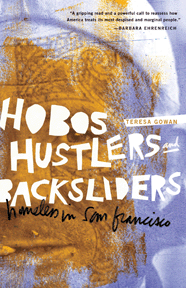
A version of this article was published in the fall 2010 edition of the San Francisco Public Press newspaper. Read select stories online, or buy a copy.
